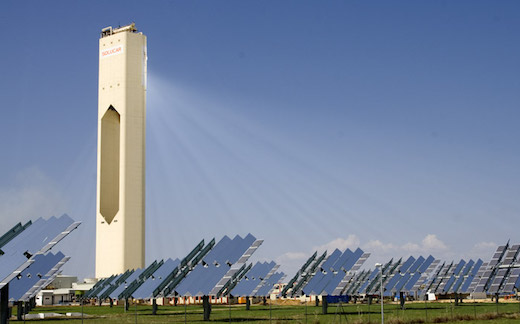
The efficiency of photovoltaic or concentrated solar power (CSP) plants depends on how much light can be captured and turned into electricity or heat. A team of researchers at the University of California, San Diego (UCSD) have made a breakthrough in this area by developing a nanoparticle material that could allow CSP plants to absorb and convert more than 90 percent of the captured sunlight into heat.
The difference between PV arrays, which convert sunlight directly into energy, is that CSP plants first convert sunlight into heat that is then used to power a steam turbine to generate electricity. Since this is very similar to how existing fossil fuel plants work, there is the potential that CSP technology could be retrofitted to existing power plants in an effort to make them more sustainable. The CSP technology also allows for the storage of electricity in thermal tanks, which makes it available 24 hours a day.
CSP plants currently consist of mirrors that focus sunlight onto a tower that is painted with a special black paint material capable of maximizing sunlight absorption. This material degrades quickly though, and therefore such plants require yearly maintenance. With the backing of the US Department of Energy’s (DOE’s) SunShot program, the UCSD researchers have now developed a new and improved light absorbing material, which is made up of particles ranging in size from 10 nanometers to 10 micrometers.

These have been spray-painted onto a metal substrate for thermal and mechanical testing, and the researchers found that the “multiscale” surface the particles form can withstand temperatures in excess of 1,292° F (700° C), and can stay exposed to air and humidity for years without deteriorating. Furthermore these surfaces can also absorb around 90 to 95 percent of light, with very little loss of heat.
Right now, CSP plants generate about 3.5 GW of power worldwide, though new plant construction is already underway which will provide around 20 GW soon. Incorporating this new nanoparticle material into the design would, of course, cut maintenance costs and raise the efficiency of these plants considerably, and bring us closer to the goal of making solar power equivalent to traditional types of power generation in the near future.
Related Articles on JetsonGreen.com:
More Environmentally Friendly Solar Cells
Solar Cells Might Soon be Made of Paper
Stacking Solar Cells Could Vastly Improve Their Efficiency

Leave a Reply
You must be logged in to post a comment.